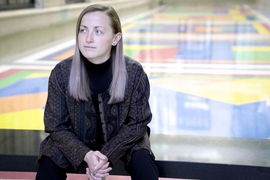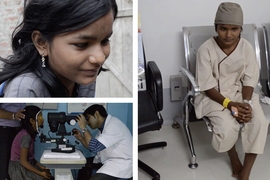According to the United Nations, 1 billion people globally live with disabilities, and as many as 70 million of them live in India. In India, individuals with disabilities face barriers to success from nonexistent or inaccessible infrastructure, as well as prejudicial beliefs and discriminatory laws.
With those challenges in mind, Kyle Keane, lecturer and research scientist in MIT’s Department of Materials Science and Engineering, was invited to conduct a 2018 summer workshop in Chennai, India. He reached out to MIT-India, part of MIT International Science and Technology Initiatives (MISTI), for support in bringing a student with him. They not only agreed, but MIT-India Managing Director Mala Ghosh replied, “Why not bring an entire class?”
MIT-India connected Keane with LV Prasad Eye Institute (LVPEI) in Hyderabad, India. The international research and training hospital offers patient care, sight enhancement, rehabilitation services, and rural eye health programs throughout India. They have served over 23 million people with visual impairments, more than half of whom were treated entirely free of charge. Keane and LVPEI partnered on a MISTI Global Seed Fund. Combining Keane’s experience with assistive technology and LVPEI’s resources and expertise in India, they aimed to create a collaboration that would have a viable impact on the assistive technology landscape. MIT and Indian participants would produce prototypes that could be field tested, receive design feedback, and — for successful products — potentially enter the manufacturing and distribution pipelines.
“The goal was to bring together MIT students and MIT-India partners for an immersive experience interweaving field visits with joint workshops in a short-course format for credit,” says Ghosh. “Given Dr. Keane’s design philosophy, curricular goals, and openness to the idea, India is an ideal location to learn and design on the ground. This whole project fuses every element of the MIT-India program by melding experiential student learning abroad, teaching and reflection in the field, forming student cohorts, developing faculty research projects, and deepening our ties with MISTI Indian partners.”
MIT-India worked with Keane to develop the India course with support from the Department of Materials Science and Engineering. The credit-bearing course brought a mix of MIT undergraduate and graduate students to Delhi, Chennai, and Hyderabad. In addition to LVPEI, MIT-India introduced the group to the Indian Institute of Technology Delhi (IIT Delhi), where MIT students worked with the Assistech Lab, as well as doctors and physical therapists at the Indian Spinal Injuries Center. The group also met with children from the nonprofit Project Prakash and its founder, MIT Professor Pawan Sinha, in Delhi to learn more about vision-restoring eye surgery. They traveled to Chennai to conduct an assistive technology hackathon with v-Shesh, an organization supporting employment training for people with disabilities. Most critically, students teamed with individuals with disabilities at each location to brainstorm designs for individuals with disabilities.
“Working with partners is critical because they have an established infrastructure and through their years of work in this area, they have developed the trust of the community,” says Keane. “We need that trust to make things happen. It’s fundamentally important that these workshops involved individuals with disabilities in order to make an impact, and coming from the U.S., we had no way to make that happen without our Indian partners.”
By collaborating directly with the client base for whom they were designing, students were also able to create technologies that were immediately impactful. They were able to receive feedback and adapt their designs to satisfy critical needs, accommodate personal preferences, and foresee issues before they arose. “I’d say my biggest accomplishment was that my team got to 3D print our first prototype system to help Aishwarya, a woman with a visual impairment, identify and label matching clothes,” says Autumn Geil, a sophomore studying materials science. “It was so rewarding to address a problem, ideate a solution, and 3-D print a prototype.”
Students were encouraged to engage with topics creatively and actively problem-solve with their co-designers. “This class enabled both us and students across India to become more aware of the difficulties faced by those with disabilities while giving us the tools to start development of an assistive technology product to improve their lives,” says Mark Vrablic, a senior studying electrical engineering. “I was able to gain a different perspective on assistive technology outside of the U.S.A. while helping promote a different approach to hands-on education and design.”
“The goal for MIT-India is to foster international collaboration between MIT and India. We exceeded our goals on many levels,” says Ghosh. “Both MIT and Indian students left with opportunities for internships, further research, and design follow-up on their ideations. The faculty also left with new interconnected research projects at IIT Delhi, LVPEI, Apeejay Stya University, and Project Prakash as a result. We hope to replicate this pilot and generate more courses abroad with other MIT departments.”
“We have five UROPs (Undergraduate Research Opportunities Programs) that have come back to MIT inspired by what students documented during their time in India,” says Keane. “We hope to bring future students to India and have former students serve as mentors while bringing their designs forward.” Keane continues to work with MIT-India partners to advance assistive technology and the humanistic co-design process. “We have a lot of ideas and passion for bringing these projects back to India,” he says. “We need student experts and we need a multidisciplinary approach because assistive technology has no single department — it’s a real combination of disciplines. We need a diverse group of students and we need mentorship so we can understand how it all comes together to make a successful product. No one of us can do it on our own.”
To hear more about this project listen to students, Keane, and MIT-India on MISTI Radio.
MISTI creates applied international learning opportunities for MIT students that increase their ability to understand and address real-world problems. It bolsters the Institute’s research mission by promoting collaborations between MIT faculty members and their counterparts abroad. MISTI collaborates with partners at MIT and beyond, serving as a vital nexus of international activity, to enable and inspire international projects and initiatives.
MISTI programs are made possible through the generosity of individuals, corporations, and foundations. For more information, email misti@mit.edu or contact country program managers directly. MISTI is an experiential program in the Center for International Studies within the School of Humanities, Arts, and Social Sciences.











